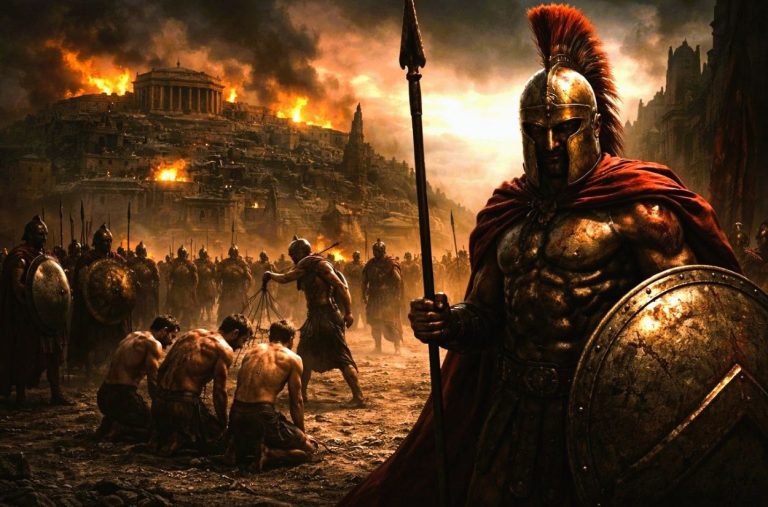
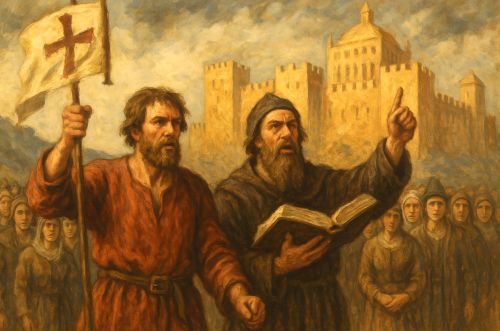
The Münster Rebellion stands as one of the most haunting episodes of the Reformation, not simply for its violence, but for what it revealed about the human quest to align heaven with earth.

By Matthew A. McIntosh
Public Historian
Brewminate
Introduction: The Fire of Radical Faith
In the volatile landscape of the sixteenth-century Reformation, Münster became a crucible for a vision that few could imagine and fewer still survive.1 What began as a modest city in Westphalia, known for its market squares and ecclesiastical traditions, transformed into the epicenter of an apocalyptic experiment that defied every norm of European Christendom. There, amid the ruins of papal authority and the birth pains of Protestant reform, Bernhard Knipperdolling and his fellow Anabaptists proclaimed that the final age of human history had dawned and that Münster would be its “New Jerusalem.”
Knipperdolling’s rise was not the work of a lone zealot but of a world convulsed by theological uncertainty. The fragmentation of Latin Christendom after Martin Luther’s defiance in 1517 produced a religious marketplace of unprecedented diversity.2 Among its more radical currents, the Anabaptists emerged as spiritual insurgents, rejecting infant baptism, clerical hierarchy, and the union of church and state.3 They believed that only those who consciously professed faith as adults could enter the true community of the elect, a conviction that invited persecution from both Protestant and Catholic rulers alike. In that crucible of oppression and hope, Knipperdolling saw divine purpose: the faithful were not merely to endure the world’s corruption but to replace it with God’s kingdom on earth.
The Münster Rebellion of 1534–1535 thus represented far more than a political uprising. It was the physical manifestation of apocalyptic expectation, where prophecy and power collided. Under Knipperdolling’s leadership (first as a guildsman and civic reformer, later as a self-proclaimed steward of divine law) the city became a stage upon which visions of communal equality, prophetic revelation, and violent purification converged.4 To its adherents, Münster was sanctified space, a city cleansed of false Christians. To its enemies, it was heresy incarnate. The siege that followed, and the terrible retribution that ended it, exposed the fatal tension between spiritual idealism and temporal order in the age of Reformation.
Knipperdolling’s story is one of faith turned ferocious, of a man who sought to legislate salvation, to impose heaven through earthly means. Yet his failure, and the grotesque spectacle of his death, did not erase the meaning of his cause. The cages that still hang from St. Lambert’s Church in Münster, where his body was displayed, remain a warning suspended in iron: the dream of a perfect world, once weaponized, becomes its own apocalypse.5
Origins and Early Life: A Merchant Turned Prophet
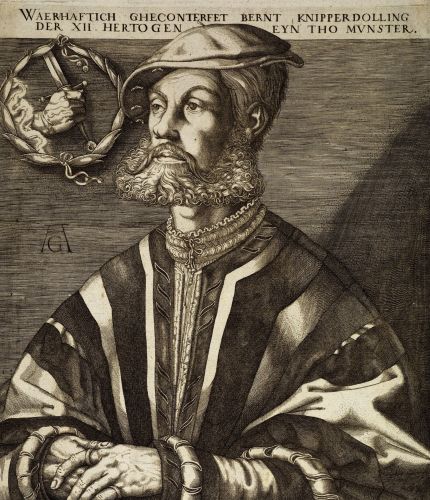
Bernhard Knipperdolling was born into Münster’s urban elite around the turn of the sixteenth century, a product of the prosperous mercantile class that sustained the city’s civic independence.6 He inherited both wealth and civic responsibility, becoming a master in the cloth trade and a leader among the city’s powerful guilds.7 This status granted him entry into the council, where debates over economic regulation and ecclesiastical power mirrored the growing unrest that would soon sweep through the empire. His education, business acumen, and local prominence positioned him not as an outcast but as a citizen reformer, a man who initially sought moral renewal within the existing order rather than its destruction.
The religious turbulence of the 1520s offered fertile ground for transformation. The writings of Martin Luther reached Münster early, carried along the same trade routes that delivered cloth and iron.8 Knipperdolling aligned himself with reformist preachers such as Bernhard Rothmann, who denounced clerical corruption and the opulence of the Church.9 Yet while Luther had appealed to princes for reform, Rothmann and his circle appealed directly to the poor. Their message, that divine truth belonged not to scholars but to believers guided by the Spirit, resonated deeply with Knipperdolling’s guild sensibility, which valued communal equality over inherited hierarchy.
By the early 1530s, a new figure altered Knipperdolling’s spiritual trajectory: the Dutch prophet Melchior Hoffmann. Hoffmann’s interpretation of the Book of Revelation envisioned the imminent return of Christ and the establishment of a New Jerusalem in northern Europe.10 His followers, the Melchiorites, preached adult baptism and the imminent cleansing of the ungodly. Knipperdolling became an ardent adherent of this vision, organizing secret gatherings where the faithful awaited the “baptism of the Spirit.” The convergence of social discontent and apocalyptic promise was electric. When Anabaptist missionaries arrived in Münster in 1533, Knipperdolling welcomed them as heralds of divine truth, opening his own home for baptisms that defied both ecclesiastical and imperial law.11
What began as reform had by now become revolution. Knipperdolling’s public embrace of adult baptism drew the ire of Münster’s bishop and Lutheran moderates alike. Expelled from civic office, he turned from guild leader to radical preacher, proclaiming that worldly powers had forfeited their legitimacy.12 In this moment of spiritual defiance, Münster ceased to be merely his city; it became his covenant, a place destined to host the final act of salvation history. The merchant had become the prophet.
The Birth of a “New Jerusalem”
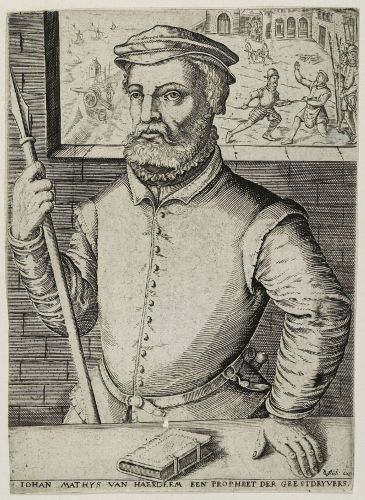
The events that unfolded in Münster between 1534 and 1535 remain among the most startling episodes in Reformation Europe, a city transformed from a Protestant stronghold into the self-proclaimed “New Jerusalem.” When Jan Matthys, a Dutch Anabaptist prophet and follower of Melchior Hoffmann, arrived in early 1534, he found in Knipperdolling a devoted ally and organizer. Together they harnessed both religious fervor and civic discontent to remake Münster as a theocratic commune.13 To the faithful, this was no rebellion but revelation: God’s kingdom was descending upon the earth, and Münster would serve as its earthly capital.
The new regime immediately instituted radical reforms that reflected the Anabaptists’ apocalyptic theology. Property was declared communal; currency was abolished; and traditional social hierarchies were leveled in the name of divine equality.14 Knipperdolling, appointed “Stadtholder,” or steward of justice, oversaw the enforcement of these new laws. He organized the redistribution of goods and the compulsory baptism of all residents, proclaiming that obedience to divine command superseded any allegiance to imperial authority.15 The city’s churches were stripped of their ornaments, its clergy expelled, and its civic institutions redefined through Scripture. In these transformations, one sees the fusion of medieval mysticism and modern revolution: an attempt to legislate paradise.
As Matthys’s prophetic authority grew, so too did the community’s isolation. Prophecy dictated military defense, and Knipperdolling helped oversee the fortification of the city against Bishop Franz von Waldeck’s besieging army.16 Inside the walls, religious ecstasy escalated into coercion. The claim of revelation justified executions of dissenters and expulsions of the “unbelieving.” Yet for Knipperdolling, these acts were not cruelty but purification, the painful pruning of a divine garden.17 What had begun as a spiritual covenant now bore the marks of totalitarian discipline.
When Jan Matthys perished in a foolhardy sortie against the bishop’s troops on Easter Sunday, 1534, leadership passed to the young tailor Jan van Leiden, who proclaimed himself King of the New Zion.18 Knipperdolling, though retaining his judicial post, became subordinate to Leiden’s monarchical vision. Under this new order, Münster’s social experiment hardened into autocracy. The introduction of polygamy, justified by Old Testament precedent and prophetic decree, epitomized the shift from collective reform to charismatic domination.19 Knipperdolling, once a civic reformer, now presided over public executions of dissenters and rival prophets. The zeal that had once driven him toward equality had become the instrument of tyranny.
Yet within this collapse lay a dark consistency. The Münster commune embodied the Reformation’s most radical impulse: the belief that divine truth could directly govern human society without mediation by pope or prince.20 Its failure would not erase that hope but recast it as warning. In the prophetic fire that consumed Münster, Europe glimpsed both the dream of an egalitarian Christendom and the nightmare of theocracy unbound.
Siege and Collapse: The Rebellion Unraveled
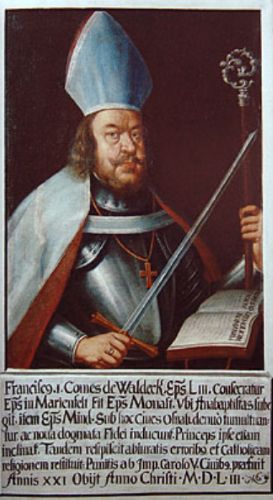
By the spring of 1534, Münster stood encircled by the forces of Prince-Bishop Franz von Waldeck.21 What had begun as a citywide revival had hardened into a desperate fortress. Inside, Bernhard Knipperdolling remained at the center of governance, not merely a political functionary, but a prophet-judge enforcing divine order in a starving city.22 The siege tested every principle the Anabaptists claimed to uphold. As food dwindled and external reinforcements failed to arrive, faith and fanaticism fused until survival itself became a sacrament.
The city’s defenses held longer than any observer expected. Knipperdolling organized militia patrols and maintained civic discipline through harsh decrees.23 In official proclamations, he declared famine a divine trial that would separate the true saints from the weak in spirit.24 Yet the unity of the “New Jerusalem” began to crack under the strain. Some attempted escape, only to be captured and executed as apostates. Others questioned Jan van Leiden’s increasingly royal pretensions. Knipperdolling, though loyal, found himself navigating the widening gulf between prophetic faith and pragmatic survival.
Outside the walls, von Waldeck’s army methodically tightened its grip. Blockades cut off all supply routes, and bombardments reduced homes to rubble.25 Inside, rationing gave way to starvation. Reports from contemporary chronicles describe citizens eating rats and grass, yet public assemblies continued with psalm-singing and ecstatic prophecy.26 Leiden proclaimed that divine deliverance was imminent, citing visions of heavenly armies descending to destroy the bishop’s troops. Knipperdolling stood beside him during these ceremonies, leading chants that blended political defiance with eschatological hope.27
But no deliverance came. By early 1535, the Anabaptist leaders faced not only external assault but internal collapse. Dissenters were executed as traitors, and discipline became indistinguishable from terror.28 Knipperdolling, acting as steward of justice, personally presided over these trials, an irony not lost on later historians who saw in him both judge and condemned. His legalism, once a reformer’s virtue, had turned into the machinery of apocalypse. The final assault on 24 June 1535 shattered the illusion of divine protection. Imperial soldiers breached the gates, slaughtering most inhabitants in scenes of grim retribution.29
In the aftermath, Knipperdolling was captured alive, alongside Jan van Leiden and Bernhard Krechting.30 The three were paraded before the bishop, interrogated, and subjected to months of public humiliation before their deaths. For Knipperdolling, the fall of Münster was more than defeat; it was the collapse of a theology that had mistaken revelation for revolution. Yet his composure in captivity suggested that he still viewed himself not as traitor but martyr.31
Judgment and Death: Martyrdom or Delusion?
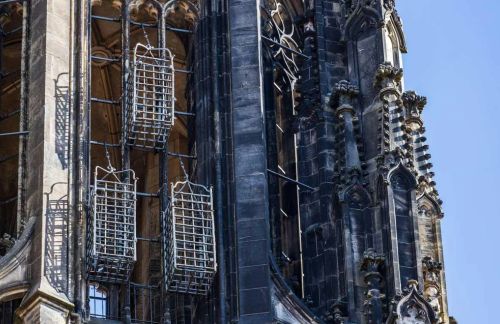
The capture of Münster’s leaders in June 1535 ended one of the most extraordinary social and religious experiments in early modern Europe. Knipperdolling, van Leiden, and Krechting were transported to the bishop’s stronghold at Dülmen, where they faced interrogation by ecclesiastical and imperial authorities.32 Unlike their defiant proclamations within Münster’s walls, the captured leaders now confronted the full weight of the Holy Roman Empire. To the bishop and his allies, their rebellion had been not merely heresy but treason, an attempt to overturn the divine and political order of Christendom.33
Knipperdolling’s conduct during imprisonment reflected the contradictions that had defined his life. Contemporary reports, preserved in Catholic chronicles, describe him as alternately penitent and obstinate, oscillating between remorse and prophetic conviction.34 Some accounts claim he recanted under pressure; others insist he held to his belief that Münster had been God’s chosen city. The surviving evidence is ambiguous, filtered through polemical lenses eager either to demonize or to sanctify him.35 Yet it is clear that Knipperdolling never betrayed the essential logic of his faith: the conviction that divine justice superseded all earthly authority.
In January 1536, after months of deliberation, the bishop ordered the public execution of the three leaders.36 The sentence was designed for spectacle as much as retribution. Before a massive crowd in Münster’s principal market square, the condemned were torn with red-hot tongs for an hour before being executed by sword. Their bodies were then suspended in iron cages affixed to the steeple of St. Lambert’s Church, a macabre warning visible for miles around.37 Knipperdolling’s cage, along with those of his companions, still hangs there today, a relic not of sanctity but of fear: fear of faith unrestrained, of revolution clothed in revelation.38
The symbolism of Knipperdolling’s death echoed far beyond Münster. For Catholic and Lutheran propagandists alike, it confirmed the dangers of religious enthusiasm and the folly of rebellion against ordained authority.39 The image of the “King of Münster” and his judges became shorthand for chaos and fanaticism. Pamphlets circulated across Europe portraying the city’s fall as divine vindication, the triumph of order over anarchy. Yet among underground Anabaptist circles, the story took a darker hue. Some saw Knipperdolling as a cautionary tale of false prophecy; others viewed him, however flawed, as a martyr who had dared to seek the kingdom of God without compromise.40
Knipperdolling’s end thus straddled two moral universes. To his contemporaries, he embodied blasphemous revolt; to later historians, he represented the tragic extremity of a movement born from genuine spiritual hunger. His death was not the extinguishing of madness, but the consummation of a vision, a failed, desperate attempt to make heaven tangible in a world not ready for it. In the final paradox of his life, the merchant who had sought to perfect society by faith alone became the most enduring emblem of its collapse.
Aftermath and Legacy: The Memory of Münster

The fall of Münster did not extinguish the radical energies that had produced it; it merely dispersed them into the undercurrents of Reformation Europe.41 Surviving Anabaptists fled north into the Low Countries and east into Moravia, carrying with them both the trauma of defeat and the hope of renewal. The name “Münsterite” soon became synonymous with extremism, a label weaponized by opponents to discredit all Anabaptists, regardless of their actual beliefs.42 Within months, even moderate reformers such as Menno Simons sought to distance their communities from the legacy of Knipperdolling and Jan van Leiden, emphasizing pacifism, humility, and separation from worldly politics.43 The transformation from violent apocalypticism to nonviolent communalism marked one of the most striking evolutions in the history of religious dissent.
Yet Münster’s specter lingered in the European imagination. For both Catholic and Protestant authorities, it served as a potent cautionary myth, proof that unchecked spiritual enthusiasm could dissolve the bonds of civil order.44 The cages on St. Lambert’s Church became public pedagogy, an architectural sermon in iron. Every rusted link embodied the warning that divine law, when seized by human hands, produces not heaven but horror. Chroniclers, artists, and preachers repeatedly invoked the rebellion to justify persecution of dissenters and the consolidation of state control over religion. The dream of the “New Jerusalem” had thus become the cornerstone of modern confessional discipline.
Even so, the story refused to fade into mere propaganda. Enlightenment writers later reinterpreted Münster through the lens of reason and human folly. Voltaire mocked the episode as proof of superstition’s absurdity, while later Romantic historians saw in Knipperdolling’s tragedy a distorted yearning for justice.45 In the nineteenth and twentieth centuries, scholars such as Friedrich Engels and Norman Cohn would recast the rebellion as a prototype of revolutionary movements, a “premature socialism” rooted in religious language.46 Though such readings risk anachronism, they underscore the enduring fascination with Münster as a mirror for Europe’s own utopian impulses.
Modern historians have sought to recover a more nuanced understanding of Knipperdolling and his followers. Far from simple fanatics, they were participants in a profound crisis of meaning at the dawn of modernity.47 The disintegration of medieval Christendom left spiritual space that neither Catholic hierarchy nor magisterial Protestantism could fill. The Anabaptists of Münster attempted to rebuild the world upon immediate revelation, a perilous venture, yet one that exposed the limits of both authority and reform. Their failure, rather than discrediting the desire for communal righteousness, revealed the tragic tension between conscience and coercion that continues to shape political theology today.48
Thus the memory of Münster endures as both warning and witness. In its collapse, we glimpse the dangers of confusing conviction with command, faith with force. Yet we also discern the unquenchable human yearning for justice beyond institutions, a longing that resurfaces in every age under new names and new banners. The iron cages remain not only as relics of defeat but as emblems of that enduring paradox, the will to build paradise, and the tragedy that follows when we forget the limits of our own making.
Conclusion: The Limits of Heaven on Earth
The Münster Rebellion stands as one of the most haunting episodes of the Reformation, not simply for its violence, but for what it revealed about the human quest to align heaven with earth. Bernhard Knipperdolling’s transformation from merchant to prophet captures the volatile spiritual energy of his age: a conviction that divine truth, once grasped, could reorder society itself.49 Yet his downfall exposes the danger at the heart of that conviction, the belief that revelation grants authority rather than responsibility. The same faith that sought to liberate souls became the instrument of coercion, and the same vision that promised equality produced a reign of fear.
Knipperdolling’s city was not the first to dream of perfection, nor would it be the last. Across centuries, from revolutionary communes to ideological states, Münster’s legacy has resurfaced whenever conviction eclipses compassion.50 The iron cages hanging from St. Lambert’s Church endure as symbols of this cycle, monuments not only to failure but to the enduring temptation to build paradise through power. Their presence in the heart of a modern, secular city is a reminder that history’s most destructive zeal often begins in the language of redemption.
Historians continue to debate whether Münster should be read as aberration or culmination, a theological fever dream or a necessary consequence of the Reformation’s radical freedom.51 The evidence suggests it was both: a tragic synthesis of genuine faith and human excess. Knipperdolling and his followers did not reject Christianity; they intensified it to the point of implosion. In their attempt to realize the apocalypse, they uncovered the limits of religious imagination when unrestrained by humility or doubt.52
To study Münster is therefore to confront a universal paradox: the human impulse to sanctify politics, to transform belief into law. The rebellion’s collapse marked not the end of utopian longing, but its metamorphosis into new forms (socialist, nationalist, revolutionary) each inheriting the same perilous confidence in moral certainty.53 Knipperdolling’s fate, suspended in iron and memory, continues to caution against mistaking conviction for consequence. His story does not merely belong to the sixteenth century; it belongs to every age that believes it can perfect the world by decree.
In the end, the New Jerusalem that Knipperdolling sought to build could not endure because no city built by human hands can bear the weight of divine perfection. Faith without restraint becomes tyranny; hope without patience becomes violence. The lesson of Münster, written in blood and iron, is that heaven cannot be forged, only awaited, and, in waiting, perhaps more truly lived.54
Appendix
Footnotes
- Norman Cohn, The Pursuit of the Millennium: Revolutionary Millenarians and Mystical Anarchists of the Middle Ages (Oxford: Oxford University Press, 1957), 253–257.
- Diarmaid MacCulloch, The Reformation: A History (New York: Viking, 2003), 192–198.
- George H. Williams, The Radical Reformation (Kirksville, MO: Sixteenth Century Journal Publishers, 1962), 173–181.
- James M. Stayer, Anabaptists and the Sword (Lawrence: University Press of Kansas, 1972), 138–143.
- Cohn, 275.
- Cohn, 261.
- Stayer, 136.
- MacCulloch, 220.
- Williams, 184.
- Claus-Peter Clasen, Anabaptism: A Social History, 1525–1618 (Ithaca: Cornell University Press, 1972), 102–104.
- Gary K. Waite, David Joris and Dutch Anabaptism, 1524–1543 (Waterloo: Wilfrid Laurier University Press, 1990), 24.
- Stayer, 139.
- Cohn, 262–264.
- Stayer, 140.
- Williams, 189.
- Clasen, 110.
- Waite, 27.
- MacCulloch, 224.
- Stayer, 142.
- Williams, 192.
- MacCulloch, 225.
- Stayer, 143.
- Cohn, 266.
- Clasen, 112.
- Waite, 31.
- Cohn, 269.
- Williams, 195.
- Clasen, 115.
- Stayer, 144.
- MacCulloch, 226.
- Cohn, 270.
- MacCulloch, 227.
- Stayer, 146.
- Clasen, 118.
- Waite, 34–36.
- Cohn, 271.
- Williams, 197.
- MacCulloch, 227.
- Stayer, 147.
- Cohn, 272.
- Stayer, 148.
- Clasen, 122.
- MacCulloch, 229.
- Cohn, 274.
- Peter Matheson, The Imaginative World of the Reformation (Minneapolis: Fortress Press, 2000), 167.
- Friedrich Engels, The Peasant War in Germany, trans. Moissaye J. Olgin (New York: International Publishers, 1926), 89–93; Cohn, The Pursuit of the Millennium, 279.
- Waite, 39–40.
- Williams, 201.
- Cohn, 278.
- MacCulloch, 230.
- Williams, 203.
- Waite, 42.
- Stayer, 149.
- Matheson, 172.
Bibliography
- Clasen, Claus-Peter. Anabaptism: A Social History, 1525–1618. Ithaca: Cornell University Press, 1972.
- Cohn, Norman. The Pursuit of the Millennium: Revolutionary Millenarians and Mystical Anarchists of the Middle Ages. Oxford: Oxford University Press, 1957.
- Engels, Friedrich. The Peasant War in Germany. Translated by Moissaye J. Olgin. New York: International Publishers, 1926.
- MacCulloch, Diarmaid. The Reformation: A History. New York: Viking, 2003.
- Matheson, Peter. The Imaginative World of the Reformation. Minneapolis: Fortress Press, 2000.
- Stayer, James M. Anabaptists and the Sword. Lawrence: University Press of Kansas, 1972.
- Waite, Gary K. David Joris and Dutch Anabaptism, 1524–1543. Waterloo: Wilfrid Laurier University Press, 1990.
- Williams, George H. The Radical Reformation. Kirksville, MO: Sixteenth Century Journal Publishers, 1962.
Originally published by Brewminate, 10.23.2025, under the terms of a Creative Commons Attribution-NonCommercial-NoDerivatives 4.0 International license.


